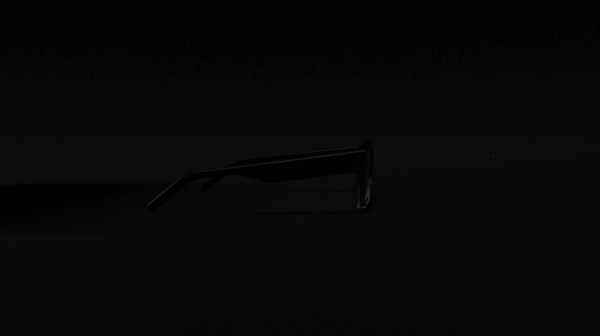The question of whether or not you should buy Augmented Reality smart glasses is being asked more often these days. With yesterday’s announcement from North stating that the company will be releasing its Focals 2.0 smart glasses next year*, and with rumours surfacing throughout 2019 as to whether or not major smartphone manufacturers (namely Apple and Samsung) will be taking a stab at making their own smart glasses (based on patent applications filed by the companies), it seems that now is as good a time as any to consider the answer.
*North has stated that it will continue to support first its generation Focals, with consistent updates rolling out in the coming months. It is their first generation model that I will be covering in this article.
I have been using my Focals by North for the last two months now, and I’ve made an effort to wear them as much as I possibly can during that time. Although, two months in, the word effort doesn’t seem appropriate any more. Wearing Focals is now part of my routine, and the glasses have honestly become a staple part of my daily technology, and even my wardrobe for that matter.
I first received my pair of Focals on October 10th, and after a short while trying to figure out how to actually set the glasses up, I was finally ready to go. My first impressions based on the set-up process were that I was actually going to immediately break things. You have this slick piece of kit, and the set-up instructions literally say “bend the temple ends”, so as to ensure a snug fit around your ears. So, brand new glasses, and the first thing you do out of the box is bend them. This almost seemed like a leap of faith, firstly in myself in that I had to trust that I was not going to snap my new hardware in half, but secondly, in North, who were asking me to bend their product. That being said, it was all part of the experience, and of course, you do need to simply trust that the company knows what it is doing, and is asking you to do this for a legitimate reason.
This reason is simple – Focals are bespoke for each user. This manual adjusting of your glasses is almost like your rite of passage to owning them. In fact, the process from start to finish with Focals is one that is focused on the individual user. These are not mass-produced, one-size fits all smart glasses. Focals are made for you, and only you. Initial measurements actually took place for me well before I owned my glasses, and involved having my head digitally scanned in one of North’s pop-up stores. The company literally scans the wearer’s head, so as to ensure that the finished product sent to the end user is as unique and custom-made for the individual as it can be. Since my visit to the pop-up store, the company has actually released an iOS app that allows prospective buyers to scan their heads from the comfort of their own home with an iPhone, making the sizing process for Focals even more convenient for users.
Convenience is actually one of the great selling points of Focals as well. It might sound dumb, but thanks to my Focals, I am now able to have an almost entirely hands-free interaction with my smartphone… almost entirely, since you control Focals with the ‘Loop’, a small ring that features a four directional joystick and button – but you can still drink your mug of coffee, and scroll through your notifications using the same hand thanks to the Loop. One of the things that I was actually sceptical about prior to owning my Focals was whether or not they were just a piece of superfluous technology. However, after two months of using them, I really don’t think this is the case. Granted, it is not much effort to get your phone out of your pocket and check your texts, but studies have shown that people are now checking their phones anywhere from 80 to 300 times a day, or, around once every 12 minutes! This is something that North actually addresses too, with the company stating that it hopes Focals will help people use their phones less. Needless to say, they certainly deliver on this – on days that I have been wearing my Focals, my screen time on my phone is reduced on average by around 30 minutes.
Humans are starting to develop an unhealthy dependency on their smartphones. We use them to distract ourselves from what is going on around us, and in doing so, we are developing terrible posture that will guarantee us a trip to the chiropractor in later life in order to adjust our crooked necks. Sorry to sound like everyone’s parents ever here, but it’s true – our phones are causing us strain, injury, and even depression. With Focals, you don’t feel this though – instead, you can still experience all that is going on around you, whilst still simultaneously being connected to your digital life (and also maintaining great posture) – and that is not a bad thing!
This was also something I had questions about before using my Focals, and I wasn’t sure if I even wanted to be constantly plugged in to my notifications. However, there is a very simple solution to this and for those that want to disconnect, and that is simply, take the Focals off. But for me even then, the temptation to check my phone would still remain. One benefit of Focals is that if you don’t see a notification appear in your eyeline, then you can be pretty certain that nothing is going on on your phone, and even if you still want to check, rather than getting distracted by the endless possibilities for procrastination that your phone represents, Focals really help to curb any habitual checking, as once you’ve pressed the button on the Loop and you have seen that there are no new notifications, you just carry on with what you were doing. There really is very little disruption, as your gaze is effectively still fixed at whatever task you had in hand anyway.
There is something unique about knowing what is going on in your own digital domain whilst still being connected to the world directly in front of you, instead of walking along with with your eyes pointed downwards at a phone screen. With Focals, you can be fully aware of what is going on around you, whilst at the same time being fully aware of what is going on on your phone. I hate to use this word, but honestly, simply put it really is quite nice. It is as if you are in on this big secret that no one else knows about, only the secret is your own calendar reminders telling you to put the recycling out in the evening for tomorrow morning’s collection. You can have hands in your coat pockets, yet still be texting your friends, getting walking directions, learning one of five languages through the flash cards feature, or keeping track of the football scores, and you can do all this without missing a beat in the real world.
One thing I have found particularly enjoyable about Focals is getting to wear them whilst sat in particularly long meetings. If you got out your phone in the middle of a meeting and started checking twitter and hockey scores, you’d probably (deservedly) earn a few glares of contempt. With Focals though, no one suspects anything (unless you have the sound on full, in which case, everyone will probably wonder what the constant chirping noise is). You can be physically present in whatever meeting it is that may not be able to maintain your undivided attention, but still be keeping on top of your digital admin. Or if you really want, you can just try to crush your high score on the log jumping game (mine is 28… it’s actually surprisingly difficult). Either way, the beauty of Focals, and the reason that no one suspects anything is all down to the way these smart glasses look.
Focals just look… normal, but this is what makes them so special. I’m sure ‘nice’ and ‘normal’ aren’t exactly what the folks at North want to hear when it comes to describing their product, but these aren’t bad things. In fact, it’s quite the opposite. Focals aren’t an enormous spectacle to wear – there are no flashing lights, no straps holding them on your head, and no screens for others to see and ask questions about. Instead, they just look like a normal pair of glasses, with perhaps only a slightly thicker temple arm than a regular pair of reading glasses. Focals are also available in prescription, and therefore serve a purpose outside the realms of augmented reality for those users that actually need glasses anyway. There are some augmented reality glasses currently on the market that may offer vastly increased functionality and features compared to Focals, and that are capable of full 3D gaming and complex spatial computing, but practically speaking, it is probably going to be several years before glasses with this level of functionality are no longer accompanied by an external compute device, or even before they no longer make the wearer look so goofy whilst using them.

When it comes to style, North is leading the way. With Focals, I can wear them knowing that no one will incorrectly assume I am spying on them. Most people don’t even notice that I’m wearing augmented reality glasses, and those that do are either also fellow techies who can appreciate the hardware, or for some reason, people that have a background working in security (I still haven’t figured out why this is yet).
This can pose a problem though, with one example being on the commute to and from work. Whilst riding transit wearing Focals, I have sometimes found myself seemingly staring straight at the person sat across from me. Of course, this is due to the fact that I’m engrossed in the Focals daily trivia game, or because I’m learning French on the language flash cards. However, other transit users don’t know this, so the onus is on the wearer to not creep other people out by inadvertently maintaining eye contact for an uncomfortable amount of time.
Another huge positive I’ve found from wearing Focals is that I genuinely have been drinking more water. Focals pop up with a little reminder about every hour or so, letting me know that I need to have a drink of water. Most people probably don’t drink enough water throughout the day, so to have a device actively telling you to do it really helps, and it is also very hard to ignore it when you know you should be doing it anyway. Other positives include, as mentioned, a reduction in my phone usage and screen time. This is also something the glasses notify you of, as they sync up with your phone’s fitness or health tracker apps. Also, my reaction time has likely increased, thanks to that high score of 28, and repeated efforts to beat it.

One question that I’ve had from people curious about my Focals is whether or not they will damage my eyes. However, I think this question arises due to a misunderstanding of how the display works (and a misconception over smart glasses in general), which stems from the fact that people think you are effectively placing a screen less than an inch from your eye. This is not the case though. Focals smart glasses do not utilize conventional screens. Instead, they use a small projector, which projects an image onto a transparent holographic film on the right lens. Red, green, and blue light from the projector interact with this film like a mirror, and bounce the light back towards the wearer’s eye, projecting images in their line of sight. Information therefore appears in the wearer’s eyeline as if it were hovering in front of them in the real world, versus how people seem to imagine it works, which basically sounds like the equivalent of holding your phone up directly in front of your face.
Therefore, the whole point of the display is that it is superimposed over your real life view in such a way that it doesn’t mean you are squinting to read notifications. Instead, information is gently overlaid and placed within your regular gaze in a way that allows you to easily read it when you want to, but is not intrusive if you don’t need to see it anymore. Images fade away after a few seconds anyway, so you don’t have a constant heads up display in your line of sight all day.
Generally when people ask me about my Focals, it is often easier to just let them try the glasses on for themselves. The problem with this though is that, as mentioned earlier, Focals are highly customized for the individual that owns them, therefore lending them to different users can really inhibit their initial experience. Since the positioning of the display is so finely tuned to the owner’s eyes, the glasses often won’t be optimally set up for another person to see things clearly.
As well as not really being able to properly show off just how great Focals are to other people, there are some other cons that I have noticed over the last couple of months wearing them – they are not perfect after all. One of the main downsides that I have noticed is the fact that after a day of wearing Focals, you begin to notice their weight, which is between 65-80 grams (depending on size, style, and lenses). As a result, I find myself taking a break from wearing them, purely from a comfort point of view. You can wear them all day whilst at work though, if you don’t mind the extra weight of the glasses resting on your nose. However, with yesterday’s announcement of Focals 2.0, North has stated that it has miniaturized its technology for its second generation model by 40%. Things can therefore only improve in terms of weight and this means that Focals 2.0 will be lighter than the first generation model. It therefore seems likely that users will probably be able to wear Focals 2.0 for longer periods of time without feeling the need to take them off.
Another thing I’ve found is that if you are walking fairly briskly, it can cause Focals to move and slip ever so slightly from their optimal display position. As everything is so finely tuned, even the smallest adjustment can mean you can no longer see your display. You therefore wouldn’t wear Focals on a run for example. There have also been a few occasions where my glasses have thought I’ve been driving, when I’ve in fact been stood completely still. However, the driving alert message can be dismissed fairly easily, plus North releases software updates, which often address these sorts of issues. Finally, I can’t help but feel like they are fragile, and I’m terrified of dropping them or wearing them out in the rain – the latter of which seems illogical, as I know that Focals are in fact splashproof and designed for IP55 certification. To be fair, I’ve never at any point felt like the glasses were going to fall off my head, and they do feel very secure once adjusted correctly. I think that these concerns are therefore more down to the fact that my Focals are still a very new item for me. As a result, I’m still protective of them as a prized possession, in the same way that anyone would want to take greater care of a brand new smartphone, or a new car.
Minor issues and personal hang-ups aside, Focals are still extremely impressive. As augmented reality technology improves, the question will no longer be one of whether or not you should buy a pair of smart glasses, but instead, which ones. Focals therefore seem like the obvious choice for consumers, as for USD $599, they are the most stylish smart glasses available at the moment. They also seem to be the only pair you can get that genuinely look like regular glasses, whilst still offering advanced augmented reality functionality. Plus, things are only going to improve with Focals 2.0, which are now just on the horizon and will be available in 2020. It seems like Focals 2.0 could be the best way to start off the next decade, because in 10 years time, it seems entirely possible that smart glasses adoption will have fully taken off. Remember, that the first iPhone only came out 12 years ago – could it be that North has done for consumer augmented reality smart glasses what Apple did for the smartphone..?
I’m hoping so.

Image & video credit: North/Auganix
About the author
Sam is the Founder and Managing Editor of Auganix. With a background in research and report writing, he has been covering XR industry news for the past seven years.
